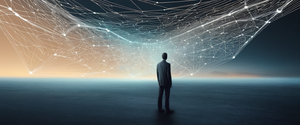
The discovery of compromised organizational data on the dark web represents only the visible tip of a sophisticated underground supply chain that transforms stolen credentials and sensitive information into operational weapons for cybercriminals. Dark web scanning and exposure monitoring have become critical defensive necessities, as organizations face unprecedented threats from an interconnected ecosystem of threat actors, data aggregators, initial access brokers, and specialized cybercriminal service providers. This comprehensive analysis examines how organizations can understand, monitor, and respond to data exposure across the complex supply chain that extends from paste sites—where data frequently first appears—through the brokers who package and weaponize this information for deployment in ransomware campaigns, credential stuffing attacks, and advanced persistent threats.
Understanding Dark Web Scanning and Digital Exposure Monitoring
Dark web scanning and digital exposure monitoring have evolved from specialized security practice into an organizational necessity as the volume of compromised credentials and data breaches continues to accelerate. Dark web monitoring is fundamentally the process of continuously scanning hidden areas of the internet that are inaccessible through conventional search engines, searching for an organization’s specific information or industry-relevant threat indicators across the deep web, dark web forums, and encrypted networks. These monitoring services provide real-time visibility into threats that traditional security tools cannot detect, offering organizations the critical ability to identify exposed data and the duration for which that data remains accessible before threat actors exploit it.
The urgency of implementing comprehensive dark web monitoring arises because stolen data frequently finds its way into criminal forums, black-market marketplaces, and underground trading networks where it becomes a high-value asset for cybercriminals. When an organization’s information—whether employee credentials, customer data, intellectual property, or system access details—lands in the hands of data brokers and specialized threat actors, it does not merely sit passively in a database but rather becomes actively weaponized for subsequent attacks. The intelligence value of brokered data enables threat actors to launch highly sophisticated attacks such as targeted phishing schemes, executive impersonation scams, and technical exploits aimed at known system weaknesses that organizations have failed to patch or remediate. This transformation of data into operational capability creates multiple opportunities for attack that extend far beyond the initial breach.
The Infrastructure of Dark Web Scanning
Dark web monitoring continuously searches the dark web and aggregates raw intelligence in near real-time, pulling millions of sites and analyzing specific information such as corporate email addresses, company names, and industry identifiers. When threats are discovered through this process, organizations can create customized alerts that notify relevant team members across marketing, legal, human resources, fraud, and security functions. The most effective dark web monitoring platforms capture data across multiple infrastructure layers, including the surface web indexed by search engines, the deep web containing private databases and subscription services, and the dark web consisting of anonymized sites requiring specialized access tools like the Tor browser. Advanced monitoring solutions integrate threat intelligence feeds from dark web forums, paste sites, leak dumps, and marketplaces to search for organization-specific compromised data, including employee and customer credentials, stolen intellectual property, internal documents, financial data, and session cookies.
The technical architecture of dark web scanning requires specialized knowledge of threat actor communities, their communication patterns, marketplace operations, and the evolving techniques used to distribute stolen data. Many monitoring platforms supplement traditional onion site surveillance with monitoring of Telegram channels and Discord servers, as threat actors increasingly use these mainstream platforms to distribute stolen information, coordinate attacks, and advertise illegal services. This migration to encrypted messaging applications represents a significant evolution in the threat landscape, as criminal operations become more distributed and harder to track through traditional forum-based monitoring approaches.
The Initial Exposure Layer: Paste Sites as Entry Points to the Supply Chain
Paste sites occupy a critical position in the data supply chain as frequently the initial public repositories where compromised information first appears before spreading to commercial marketplaces and private channels. These platforms function as text storage services designed to host various forms of plain text content, offering syntax highlighting for programming languages and providing both public and private sharing capabilities. Paste sites emerged initially as legitimate tools for developers and researchers to collaborate and share code, logs, and configuration files, but have become increasingly instrumentalized by threat actors as distribution hubs for stolen credentials, proprietary code, database dumps, and sensitive organizational information.
Pastebin.com, established in September 2002, represents the most prominent and long-established paste site in the threat actor ecosystem. Although the platform emerged as a legitimate service, Pastebin.com has become renowned in security communities as a prominent source of links to dark web resources and a primary distribution channel for data breaches, leaked credentials, and stolen databases. The platform’s minimal barriers to entry—allowing guest users to submit pastes without registration or authentication while restricting administrative oversight—have created an environment uniquely conducive to illicit activities. Threat actors frequently exploit Pastebin’s built-in privacy features, creating private links with time-based access restrictions that allow them to control exactly who can view sensitive information and for how long. These operational security capabilities, combined with the platform’s lack of strict content moderation and the difficulty of distinguishing malicious pastes from legitimate technical content, make Pastebin an ideal staging ground for initial data exposure.
Beyond Pastebin.com, the paste site ecosystem includes numerous alternatives that threat actors employ strategically based on their operational needs and threat actor preferences. JustPaste.it, dpaste, PrivateBin, and ZeroBin offer varying levels of anonymity and encryption, with some platforms implementing client-side encryption that prevents even platform administrators from accessing posted content. GitHub Gist has unexpectedly become a vector for data exposure, as threat actors exploit secret Gists to distribute malware, stolen credentials, and sensitive configuration files while leveraging GitHub’s perceived legitimacy to bypass security filters and email gateways. These paste sites share common characteristics that make them attractive to threat actors: they require minimal authentication, offer rapid accessibility, provide some level of anonymity, and receive minimal active content moderation from administrators who are overwhelmed by the volume of submissions.
Paste Sites as Precursors to Broader Campaigns
The threat posed by paste sites extends beyond their function as data repositories; they frequently serve as early warning indicators that an organization or individual has been compromised and whose data is likely to be traded more broadly. When security researchers and threat intelligence analysts discover an organization’s data on Pastebin or similar platforms, it typically signals that the information has already been exfiltrated and that threat actors are moving toward monetization through commercial channels. In many cases, paste site publications represent deliberate marketing by threat actors seeking to establish credibility or generate auction interest before listing the same data on dark web marketplaces. The timeline from paste site publication to active exploitation can be remarkably compressed, with some threat actors using paste sites merely as proof-of-concept demonstrations before moving to more profitable sales channels within hours or days.
Organizations that discover their data on paste sites face immediate operational dilemmas that complicate response efforts. Unlike data breaches that organizations control in their initial phases, paste site exposures are public and potentially irreversible, as multiple threat actors may have already downloaded and cached copies of exposed information before the original paste is deleted. Attempting to have information removed from paste sites often proves futile, as these platforms operate across multiple jurisdictions and may lack the resources or motivation to respond to removal requests quickly enough to prevent widespread copying. Furthermore, internet search engines continuously cache web content, and removing a paste from its original host does not ensure removal from search engine caches, meaning the information remains publicly discoverable through standard search techniques. This reality necessitates that organizations approach paste site exposure with immediate containment objectives focused on damage assessment and response activation rather than data deletion, which is typically no longer feasible.
The Aggregation and Monetization Phase: From Leaks to Commercial Channels
Once data appears on paste sites or is directly harvested through cyber attacks, it enters the aggregation and monetization phase of the supply chain where specialized threat actors and criminal enterprises consolidate, categorize, and repackage information for sale to downstream consumers. This phase represents the critical transformation point where stolen data transitions from initial exposure to operationalized criminal asset. Dark web marketplaces have evolved into increasingly professional and sophisticated platforms designed to facilitate trust and efficiency among criminals, employing features such as vendor reputation systems, escrow services, transaction ratings, and specialized categorization schemes that mirror legitimate e-commerce platforms. These marketplaces generate billions of dollars in annual revenue, with 2024 estimates placing dark web marketplace revenues at approximately $2 billion despite significant law enforcement disruption efforts.
The evolution of dark web marketplaces reflects increasing specialization within the cybercriminal ecosystem, with different platforms targeting distinct criminal audiences and data types. Classic darknet markets such as Abacus Market and Russian Market function as general-purpose bazaars offering everything from drugs and counterfeit documents to hacking tools, stolen credentials, and malware. Data-specialized marketplaces such as Brian’s Club focus specifically on stolen financial information including credit card dumps and personal identity details, with BriansClub alone conducting over $126 million in transactions before receiving law enforcement attention. Emerging platforms like Exodus, which launched in 2024, have rapidly gained prominence by specializing in infostealer logs—the packaged compilations of stolen credentials extracted by malware—at price points designed to attract even low-skilled threat actors with minimal operational budgets.
The pricing structure within dark web marketplaces functions as a real-time threat index revealing which data types command highest demand among cybercriminals and consequently which organizational assets face greatest risk. Stolen credentials of varying types command different market values based on their utility and monetization potential. Social Security Numbers sell for approximately $1 to $6, while bank login credentials command significantly higher prices ranging from $200 to over $1,000 depending on account balance and associated restrictions. Cryptocurrency account credentials fetch prices around $1,100, reflecting their direct monetization potential without intermediaries. Complete medical records remain among the most expensive personal data, selling for $500 or more, due to their combination of personally identifiable information and health history that enables sophisticated fraud targeting. This pricing structure directly reflects the criminal supply-and-demand economics of the dark web, with data providing direct paths to monetization commanding the highest prices while supporting information commands lower prices.
Subscription-Based Models and Private Cloud Access
A significant evolution in dark web data monetization has emerged in recent years with the shift from traditional one-time file sales to subscription-based private cloud access models. Rather than selling individual data breaches or logs to single purchasers in one-time transactions, cybercriminal enterprises increasingly operate private cloud repositories containing continuously updated collections of millions of stolen credentials, compromised accounts, and infostealer logs accessible only through paid subscription tiers. These private clouds represent a fundamental business model improvement for cybercriminals, offering advantages including recurring revenue streams, reduced risk from law enforcement exposure as repositories are kept offline and access is carefully controlled, protection against individual sales creating public discovery of data, simplified customer management and payment collection, and the ability to aggregate data from diverse sources into unified searchable repositories.
The implications of this subscription transition for organizations and individuals are profound and concerning. Traditional data breach models might result in specific stolen datasets being sold to a limited number of buyers, with some finite lifetime before data loses market value and is abandoned. Subscription-based private clouds extend the operational lifetime of stolen data far beyond typical breach-to-compromise timelines, with lifetime access subscriptions allowing data to be accessed and exploited months or even years after initial compromise. Additionally, the democratization of access through subscription models enables tens, hundreds, or potentially thousands of concurrent subscribers to access identical datasets, dramatically expanding the number of potential threat actors capable of exploiting any given organization’s exposed information. This proliferation of access, combined with decreasing subscription costs that enable even low-skilled actors to participate, creates exponentially greater risk surfaces than traditional breach-to-sale timelines suggested.
The Role of Initial Access Brokers in the Supply Chain
Initial Access Brokers (IABs) occupy a specialized and increasingly central position within the cybercriminal supply chain, operating as specialized intermediaries who gain unauthorized access to corporate networks and subsequently sell that access to the highest bidders on underground forums and through direct channels. IABs do not execute final attacks themselves; rather, they focus exclusively on establishing persistent access into target networks, documenting the access capabilities, and marketing those access packages to threat actors including ransomware operators, data theft groups, and other specialized cybercriminals. This specialization and division of labor has become a defining characteristic of modern cybercriminal operations, enabling ransomware groups and other threat actors to scale their operations dramatically by outsourcing the difficult initial reconnaissance and access establishment phases to specialists who maintain multiple compromised networks in inventory ready for sale.

IAB Access Vectors and Network Compromise Techniques
Initial Access Brokers employ diverse methodologies to establish their initial network compromises, with techniques including scanning for vulnerabilities using tools like Shodan, exploiting known security flaws in internet-facing applications, conducting phishing attacks to harvest credentials, performing credential stuffing attacks against exposed credential lists, brute-forcing Remote Desktop Protocol (RDP) and Virtual Private Network (VPN) services, and leveraging social engineering techniques including help desk impersonation. The dramatic expansion of remote access infrastructure following the COVID-19 pandemic significantly expanded the attack surface available to IABs, as organizations relied increasingly on RDP and VPN technologies to enable remote work without implementing sufficient security hardening, multi-factor authentication, or network segmentation. Compromised RDP and VPN credentials have become among the most commonly traded assets on dark web marketplaces and within IAB communities, with stolen login pairs frequently sourced from infostealer malware logs or previously exposed breach dumps.
Once IABs establish initial network access, they invest significant effort in establishing persistence and expanding their foothold to ensure their access survives credential changes, patch deployments, and standard security remediation activities. IABs may install web shells on compromised web servers, establish multiple access points through different services, create administrative accounts, and maintain backup access mechanisms to guarantee that even if an organization discovers and remediates their primary access vector, they retain the ability to re-establish entry. This persistence-focused approach requires technical expertise but dramatically increases the value of the access package, as it provides the buyer with confidence that the access will remain usable even as the organization attempts remediation activities. IABs verify their access quality, ensure adequate persistence mechanisms, and only then classify their victims by industry vertical before marketing packages on well-known hacker forums, encrypted Telegram channels, and through direct outreach to known ransomware affiliates.
IAB Activity and Market Dynamics
The market for initial access has experienced significant fluctuations reflecting both law enforcement disruption efforts and broader changes in the cybercriminal ecosystem. SOCRadar monitoring data documents that initial access incidents tracked on hacker forums increased from 785 unique incidents in the first half of 2023 to 965 incidents in the first half of 2024, representing a 22.9% increase. This growth trend accelerated following successful law enforcement operations against major ransomware groups, particularly operations that disrupted ALPHV and LockBit, which temporarily reduced demand but were followed by rapid market recovery as alternative ransomware groups expanded their operations and adopted RaaS business models. The first half of 2024 saw 965 initial access incidents listed for sale on hacker forums, with annual projections suggesting the 2024 total would exceed the 1,812 incidents documented during all of 2023.
Pricing dynamics within the IAB market reveal important trends regarding both threat actor priorities and operational pressures. Security researchers have documented that prices offered by IABs for network access have trended downward, potentially reflecting both oversaturation as IABs compete aggressively to build access portfolios and strategic decisions by threat actors to avoid high-value targets that would attract law enforcement attention. Smaller organizational compromises may sell for modest prices—as low as several hundred dollars for less strategically significant networks—while access to critical infrastructure, financial institutions, or large enterprise networks commands premiums in the tens of thousands of dollars. This pricing structure incentivizes IABs to build broad portfolios of diverse targets rather than focusing exclusively on high-value organizations, enabling them to offer options across the buyer spectrum.
Data Brokers: The Parallel Commercial Ecosystem
Alongside the specialized cybercriminal supply chain, legitimate data brokers operate a parallel ecosystem that, despite legal frameworks and business legitimacy claims, creates profound risks for organizational data security. Data brokers accumulate vast collections of personal information through numerous acquisition channels including public records databases, subscription services purchased from other data companies, information scraped from social media platforms, and data obtained from organizations that experienced breaches but lacked controls preventing onward sale. These commercial data brokers aggregate extraordinarily comprehensive information on individuals, including full Social Security Numbers, dates of birth, address histories spanning decades, email addresses, phone numbers, financial information, employment records, and vehicle registrations.
The fundamental business model of data brokers—acquiring data at minimal cost and reselling it at markup to diverse customers including law enforcement agencies, debt recovery companies, and other organizations—creates persistent incentives to accumulate and retain massive datasets indefinitely. This data accumulation practice simultaneously creates substantial security risks, as once data brokers experience breaches or have their clients breached, stolen data enters criminal channels where it becomes available for monetization through dark web marketplaces. The interconnection between legitimate data broker breaches and cybercriminal operations became starkly apparent when court documentation revealed that Interactive Data, a commercial data broker, experienced breaches that resulted in criminals using the exfiltrated data to perpetrate millions of dollars in fraudulent federal loan applications and unauthorized unemployment insurance claims.
The Data Broker Breach Cascade
The 2024 case of National Public Data exemplified the risks created by inadequate data broker security. In April 2024, a criminal actor announced breaching and exfiltrating approximately 3 billion records affecting over 300 million individuals from National Public Data, a U.S.-based data broker claiming to be “one of the biggest providers of public records on the Internet”. The leaked dataset included names, address histories, Social Security Numbers, and comprehensive personal identifiers that National Public Data compiled from public records sources but maintained in inadequately protected systems. Even partial samples of the breach data verified as authentic, with researchers able to confirm multiple individuals’ accurate name-address-SSN combinations, address histories spanning decades, and family relationship information. This breach exemplified how data brokers’ business models—collecting and consolidating information from diverse sources without robust security controls—create massive attack surfaces vulnerable to compromise.
The cascading risks from data broker breaches extend beyond the organizations themselves, as compromised data broker clients also become vulnerable when their information flows back into criminal channels. Court proceedings revealed that clients of compromised data brokers, including legitimate businesses relying on data broker services, subsequently experienced breaches when criminals weaponized the data broker-sourced information to conduct credential stuffing attacks against the clients’ systems. This transitive vulnerability demonstrates how inadequately secured data broker infrastructure essentially weaponizes information against downstream organizations that depended on data brokers’ security practices. The lack of meaningful regulation over data brokers’ collection, retention, and security practices creates a systemic risk that compromised data at any point in the data broker supply chain potentially endangers millions of individuals and countless organizations.
Information Stealer Malware and the Credential Supply Chain
Information stealer malware has emerged as one of the most prolific and dangerous attack vectors feeding credentials into the dark web supply chain, with the explosive growth of infostealer malware representing a major security trend over the past several years. Infostealers are designed to infiltrate systems and silently harvest sensitive credentials such as usernames and passwords stored in web browsers, form autofill data, authentication cookies that maintain user sessions, email credentials and contents, web browsing history, cryptocurrency wallet login information, and VPN credentials. Once infostealers harvest this data, they exfiltrate it to attacker-controlled command and control infrastructure, where threat actors aggregate and package the collected information into searchable “logs” that are subsequently sold on dark web marketplaces and Telegram channels.
The scope of infostealer compromise has reached unprecedented levels, with research indicating that 78% of breached companies had corporate credentials leaked in stealer logs within six months before or after their confirmed breach, demonstrating the pervasiveness of infostealer infections preceding or accompanying major security incidents. Furthermore, approximately 3-10% of stealer logs examined by threat intelligence providers contain credentials providing access to corporate SaaS applications, with individual infected users frequently maintaining access to more than a dozen corporate credentials spanning multiple SaaS platforms, systems, and critical technologies. This reality reveals that infostealer infections commonly precede and facilitate major cyber incidents, as threat actors use harvested credentials to establish initial access into corporate networks where they subsequently conduct reconnaissance, establish persistence, and prepare for follow-on attacks.
Infostealer Malware Families and Distribution Models
The infostealer landscape encompasses numerous distinct malware families, each with varying capabilities and distribution mechanisms. Redline has dominated the infostealer market, infecting more than half of all targeted devices (55% according to 2023 data) and accounting for 51% of all infostealer infections from 2020-2023. Other prevalent families including Vidar (17% of infections) and Raccoon (nearly 12%) demonstrate the diversity of infostealer variants actively deployed at scale. More recently, Lumma emerged as a rapidly growing threat, gaining particular prominence through a Malware-as-a-Service (MaaS) distribution model that enables cybercriminals without advanced technical skills to purchase subscriptions to pre-made malicious tools and deploy them at scale. This MaaS evolution in infostealer distribution dramatically lowered barriers to entry for cybercriminal operations, enabling even low-skilled actors to participate in credential harvesting campaigns.
The distribution mechanisms for infostealer malware have become increasingly diverse and sophisticated, with threat actors leveraging email spam, YouTube videos containing malicious download links, Discord advertisements, and social engineering campaigns targeting both individual consumers and corporate employees. Many infostealers employ sophisticated techniques to avoid detection, including process injection into legitimate system processes, bypassing of browser encryption mechanisms such as Google Chrome’s Application Bound Encryption, and exploitation of legitimate system utilities including InstallUtil.exe, MSBuild.exe, and aspnet_compiler.exe for malware execution. Some infostealer families like RedLine develop little forensic evidence on disk, complicating detection for security teams relying on file-based indicators, while others like Raccoon and Vidar leave detectable artifacts including external DLL downloads and unusual module loads.
The Economics of Stealer Logs and Credential Markets
The monetization of stealer logs has become increasingly systematic, with dedicated marketplaces and Telegram channels specializing in the aggregation and sale of stolen credential packages. Telegram channels such as Daisy Cloud (34.7 million compromised accounts published), Bugatti Cloud (16.1 million accounts), and Cuckoo Cloud (14.2 million accounts) operate subscription-based models offering daily fresh logs to paying subscribers while providing selected free logs to attract new customers. These channels frequently organize logs by geographic region, credential type (combo lists, full stealer logs, specific platform credentials), or data quality, enabling subscribers to rapidly identify and acquire credentials matching their specific targeting preferences. Prices for bulk credential access remain remarkably low, with threat actors able to acquire large credential collections for modest fees that enable rapid monetization through credential stuffing attacks, initial access establishment, or resale to other threat actors.
The consequence of infostealer proliferation for organizational cybersecurity is profound and multifaceted. Organizations face threats not only from external attackers using stolen credentials but also from insiders whose credentials become compromised through personal device infections that remain undetected by corporate security controls. An employee accessing corporate systems from a personal device infected with infostealer malware potentially exposes their corporate credentials, VPN credentials, session cookies bypassing multi-factor authentication, and any cloud credentials cached in browsers or configuration files. When multi-factor authentication is not implemented on corporate systems, stolen credentials alone prove sufficient for complete account compromise and network access establishment. Even organizations implementing multi-factor authentication face risk, as stolen authentication cookies can effectively bypass MFA requirements by restoring the user’s authenticated session without requiring re-authentication.

The Connection to Ransomware and Advanced Attack Chains
The specialization and division of labor within the cybercriminal ecosystem becomes fully apparent when examining how stolen credentials and initial access established by IABs feed directly into ransomware operations and other advanced attack campaigns. Ransomware-as-a-Service (RaaS) groups have evolved into sophisticated criminal enterprises operating with structural efficiency approaching legitimate software companies, complete with developer teams, deployment affiliates, negotiators specializing in ransom maximization, public relations staff managing online reputation, and payment infrastructure managing cryptocurrency flows. Within this organizational structure, Initial Access Brokers provide a critical function by outsourcing the difficult initial reconnaissance and network compromise phases, enabling RaaS groups to focus exclusively on attack execution, data exfiltration, and ransom negotiation.
The profitability of this model has driven expansion of RaaS operations and increased competition for initial access inventory. Palo Alto Networks’ Unit 42 incident response data from 2024 documents that network intrusion investigations comprised roughly 25% of cases, representing the single most common investigation type tracked by the firm. Extortion attacks, frequently involving data exfiltration combined with encryption, constituted the top investigation type in several regions and industries, with manufacturing seeing particularly high prevalence due to organizations’ criticality and perceived willingness to pay. The data reveals the scope of attack breadth deployed by modern threat actors, with 84% of incidents involving attacks across multiple fronts and 70% of incidents involving attacks across three or more distinct vectors including endpoints, humans through phishing, identity systems through credential compromise, network resources, cloud infrastructure, and applications.
Double and Triple Extortion Tactics
The evolution of ransomware extortion tactics from simple encryption-focused attacks to multi-stage extortion schemes represents a business model improvement for threat actors that leverages the stolen data supply chain to maximize victim pressure and ransom demands. Double extortion occurs when threat actors exfiltrate data copies before encryption, subsequently threatening to release stolen information if ransom payment is refused. This tactic has evolved from novelty to standard practice across the ransomware threat landscape, with Arctic Wolf analysis documenting that 96% of ransomware incident response cases examined involved data exfiltration enabling extortion alongside encryption. Triple extortion represents further escalation, wherein threat actors employ additional pressure tactics including launching DDoS attacks against victim infrastructure, contacting victim customers and threatening to leak their personal information, contacting business partners to extend threats beyond the primary victim, or even contacting regulatory bodies to report victim non-compliance with disclosure requirements.
These multi-extortion tactics explicitly depend on robust data supply chains that ensure stolen data remains accessible and monetizable long after initial compromise. Threat actors maintain leaked data on dark web marketplaces for extended periods, publicizing victim names to pressure ransom negotiation, and frequently re-monetize the same data through multiple channels including resale to other threat actors, identity theft operations targeting exposed individuals, and regulatory violation notifications. Recent incidents including the NHS pathology services breach involving 300 million patient interaction records demonstrate the scope of damage enabled by multi-extortion tactics, as threat actors leverage large-scale data exfiltration to create massive pressure through both regulatory violation threats and individual harm exposure.
Detection, Monitoring, and Response Strategy
Organizations must implement comprehensive monitoring and response frameworks that track threat activity across the entire data supply chain from initial paste site appearance through broker marketplace transactions and downstream exploitation. Effective dark web monitoring extends beyond simple breach notification to encompassing proactive threat hunting, early detection of impending attacks, and attribution of attack sources enabling strategic response. The most mature monitoring approaches integrate multiple data collection mechanisms including crawling of known dark web forums and marketplaces, monitoring of Telegram channels and encrypted communications, analysis of paste sites and public data dumps, aggregation of threat intelligence feeds, and correlation with organizational security telemetry to identify indicators matching exposed data.
Dark Web Monitoring Implementation and Alert Prioritization
Organizations implementing dark web monitoring must balance the comprehensive coverage necessary for threat detection against alert fatigue and investigation resource limitations that can overwhelm security teams confronted with excessive false positive alerts. Effective monitoring platforms provide risk scoring capabilities that evaluate alert context, including assessment of data freshness, combination with other organizational exposures, credential privilege level, and whether exposed credentials have been previously compromised in other breaches. Early prioritization frameworks identify high-risk exposures such as executive credentials, privileged account access, VPN or RDP credentials, system administrator credentials, and data indicating insider knowledge of organizational infrastructure. These high-risk exposures warrant immediate investigation and response, while lower-risk exposures such as individual consumer credentials to non-critical services may warrant less urgent response depending on organizational risk tolerance.
The reality of dark web monitoring is that organizations will continuously receive alerts regarding exposed credentials and compromised information, creating ongoing challenges for security teams attempting to maintain situational awareness while avoiding paralysis from alert volume. Research indicates that credentials have typical lifespans extending from initial exposure through multiple trading events spanning weeks or months, during which the same stolen credentials may be sold multiple times across different marketplaces and Telegram channels. This extended timeline creates opportunities for proactive response if organizations identify exposures early, but also creates risk of mission fatigue as security teams encounter repeated alerts regarding credentials that have already been included in prior notifications. Effective response frameworks must incorporate investigation systematization, clear escalation criteria, and integration with broader incident response procedures to transform monitoring alerts into actionable defensive measures.
Response Mechanisms and Credential Remediation
When organizations identify stolen credentials through dark web monitoring, immediate response priorities include confirming the exposure scope, identifying affected systems and accounts, isolating or disabling compromised accounts, resetting credentials for affected users, investigating potentially compromised systems for signs of unauthorized access, and implementing technical controls to prevent credential reuse. The most critical response action involves credential reset for identified compromised accounts, particularly when credentials provide access to privileged systems, remote access infrastructure, cloud environments, or sensitive applications. However, credential resets alone prove insufficient if systems have already been compromised and threat actors have established persistent access, migrated credentials, or established backdoor access mechanisms that survive remediation activities.
More sophisticated response approaches employ identity-centric intelligence to pivot from individual credential exposure to broader investigation of whether those same credentials appear in other breaches, malware logs, or marketplace listings. This credential pivoting approach treats exposed credentials as investigative hooks enabling identification of broader compromise patterns, infection vectors, and potential insider threats. When a CFO’s corporate credentials appear in an infostealer log, security teams should not merely reset that credential but rather investigate whether the endpoint was infected with malware, whether other accounts from the same organization appear in the same malware log, whether the malware strain has known distribution vectors, and whether the infection represents an isolated incident or part of broader campaign activity. This investigative approach transforms credential exposure from isolated incident into opportunity for deeper organizational security assessment and threat actor attribution.
Preventing Monetization of Stolen Credentials
Organizations attempting to disrupt the supply chain must consider whether tactical response actions might prevent or delay monetization of their compromised data on criminal marketplaces. While past security guidance emphasized immediate notification and public disclosure, emerging research suggests that premature public disclosure of data exposure may actually accelerate threat actor monetization by validating data authenticity and value to potential buyers. Some security practitioners have experimented with intentional publication delays combined with targeted monitoring of specific threat actors known to be relevant to the organization, seeking to identify buyers and better understand how compromised data enters criminal operations. However, this approach requires sophisticated threat intelligence capabilities and creates risk of delayed breach notification conflicting with legal obligations in regulated industries.
More broadly, preventing monetization requires understanding that individual organizations have limited ability to prevent stolen data from entering criminal supply chains once compromise has occurred, necessitating focus on detection and response timing rather than monetization prevention. The encryption and anonymization provided by Monero cryptocurrency transactions, the decentralization of dark web marketplace infrastructure, and the global nature of cybercriminal operations collectively render data removal efforts futile once information enters criminal channels. Organizations must therefore focus defensive efforts on preventing initial compromise, rapidly detecting compromise when it occurs, and quickly responding to credential exposure to minimize the window during which exposed credentials remain valuable and unmitigated in the hands of threat actors.
Organizational Frameworks for Exposure Monitoring and Response
Establishing effective exposure monitoring and response requires organizational frameworks integrating technology, process, and governance to ensure systematic detection and investigation of data exposure across the broader threat landscape. The threat intelligence lifecycle provides a structured framework for transforming raw dark web monitoring data into actionable intelligence driving organizational defensive response. This lifecycle encompasses six distinct phases including planning and direction to define monitoring requirements and investigation priorities, collection of raw data from dark web sources, processing and analysis to assess threat relevance and validate data authenticity, dissemination of findings to appropriate stakeholders, feedback mechanisms enabling continuous improvement, and most critically, the action phase wherein intelligence drives tangible security improvements including credential resets, system hardening, access control modifications, and technical countermeasure deployment.
Many organizations fail at the action phase of the intelligence lifecycle, generating substantial volumes of dark web monitoring data but lacking effective mechanisms to convert findings into operational security improvements. This failure may reflect insufficient integration of dark web monitoring platforms with incident response procedures, unclear accountability for responding to monitoring alerts, lack of executive prioritization for exposure response activities, or insufficient security staffing to investigate and respond to alerts at appropriate velocity. Organizations implementing successful exposure monitoring frameworks typically designate specific teams responsible for dark web monitoring alert triage, establish clear investigation procedures and escalation criteria, integrate monitoring findings with security awareness and credential management programs, and maintain dashboard visibility enabling leadership to assess organizational exposure trends and response velocity.
The Chain Unfurled
The supply chain extending from paste sites through data brokers to ransomware operators and other threat actors represents a complex, evolving ecosystem that defies simple disruption through technology or law enforcement action alone. Initial Access Brokers, data brokers, infostealer distributors, marketplace operators, and specialized service providers have developed a sophisticated commercial infrastructure that efficiently transforms stolen data into operational attack capabilities at scale. The 353 million individuals whose data was leaked in 2023 alone, combined with estimates suggesting 15 billion credentials remain available across dark web marketplaces and private repositories, underscore the magnitude of data exposure fueling this underground economy.
Organizations must adopt comprehensive strategies acknowledging that total prevention of exposure through technical controls alone remains impractical in the current threat landscape. Rather, effective defense requires multi-layered approaches encompassing rigorous data minimization and access controls to limit data exposure when breaches occur, continuous monitoring of dark web sources and threat actor communications to enable early detection of organizational data exposure, systematic response procedures enabling rapid credential remediation and investigation of compromise extent, integration of dark web monitoring findings with threat intelligence and incident response programs to enable pattern identification and proactive hardening, and adoption of identity-centric intelligence approaches that treat credential exposure as potential indicators of broader compromise patterns.
The evolution of business models within criminal enterprises—from traditional one-time data sales toward subscription-based private cloud repositories—demands that organizations assume longer operational windows for remediation and more sophisticated threat actors with extended access to compromised credentials. Threat actors increasingly maintain stolen credentials as long-term assets rather than disposable commodities, creating persistent risk windows extending months or years after initial compromise. Multi-factor authentication, credential isolation, network segmentation, and continuous authentication mechanisms become not optional security enhancements but fundamental requirements for organizations seeking to limit damage when credentials inevitably become compromised through infostealer malware, vendor breaches, or other exposure vectors.
Ultimately, addressing the data supply chain from paste sites to brokers requires ecosystem-wide efforts extending beyond individual organizations to encompass law enforcement actions against marketplace operators and threat actors, payment system disruption targeting criminal financial infrastructure, international cooperation enabling coordination against geographically dispersed cybercriminal operations, and policy interventions limiting the availability of exposed data through data minimization requirements and data broker regulation. Organizations can contribute to these ecosystem-level efforts by participating in threat intelligence sharing communities, reporting monitoring findings to relevant authorities, and refusing to pay ransoms that would fund further evolution and expansion of criminal supply chain infrastructure. Dark web monitoring and exposure response represent necessary defensive capabilities in the current environment, but their necessity highlights the urgency of broader efforts to disrupt the underlying conditions enabling the sophisticated criminal supply chains that feed modern cyberattacks.
Protect Your Digital Life with Activate Security
Get 14 powerful security tools in one comprehensive suite. VPN, antivirus, password manager, dark web monitoring, and more.
Get Protected Now





